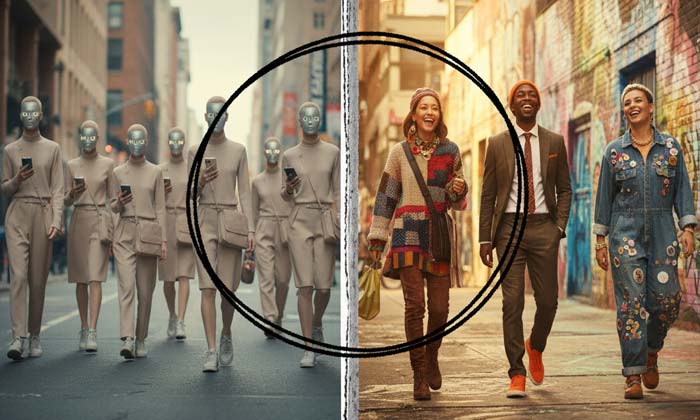Fashion has always been more than just clothing—it is a language of identity, culture, and belonging. However, in a world increasingly dominated by trends, consumerism, and brand-driven ideals, many have begun to question the purpose of fashion itself. This questioning has given rise to what is often called anti-fashion—a movement that rejects the traditional cycles of the fashion industry and instead embraces authenticity, individuality, and sustainability.
Yet, contrary to what the term may suggest, anti-fashion is not about rejecting oneself or rejecting style altogether. Instead, it is about refusing to conform to expectations that do not resonate with personal identity. Anti-fashion celebrates diversity, imperfection, and freedom from rigid beauty standards. It is a powerful reminder that fashion should serve the individual, not the other way around.
What Does Anti-Fashion Mean?
Anti-fashion refers to styles and practices that stand outside the mainstream fashion system. Unlike traditional fashion, which thrives on seasonal trends and constant renewal, anti-fashion challenges the very need for trends. It can take many forms: minimalist clothing, repurposed garments, vintage thrift finds, or even deliberate mismatching of styles.
At its core, anti-fashion is about questioning the industry’s influence over how people should look and what they should wear. Rather than dictating a single aesthetic, it opens the door to self-expression in its rawest and most personal form.
Breaking Away from Trends
One of the key ideas behind anti-fashion is the rejection of fast-changing trends. The global fashion industry thrives on constant novelty, persuading consumers to buy new items every season. This not only burdens individuals financially but also contributes to massive environmental waste. Anti-fashion disrupts this cycle by encouraging people to wear what feels right to them, regardless of whether it is “in” or “out.”
By stepping outside the trend machine, individuals reclaim their power of choice. Clothes become tools of expression rather than markers of social approval. This shift not only liberates personal style but also reduces the pressure to constantly perform an image for others.
Individuality over Uniformity
Far from being anti-style, anti-fashion is deeply personal. It invites individuals to embrace clothes that feel authentic to their identity, even if they defy conventional notions of beauty or taste. This means comfort, cultural roots, personal creativity, or even rebellion can guide fashion choices.
Uniformity, often imposed by mainstream fashion, is replaced with individuality. In this way, anti-fashion challenges the idea that identity must be curated according to consumer culture. Instead, it proves that individuality is itself a powerful aesthetic—unique, evolving, and deeply human.
Anti-Fashion and Sustainability
Another dimension of anti-fashion lies in its connection with sustainability. The overproduction of clothing is one of the biggest contributors to global waste and pollution. Anti-fashion responds to this crisis by prioritizing longevity, recycling, and mindful consumption. Vintage shopping, upcycling, and wearing clothes until they truly wear out become acts of resistance against environmental damage.
This movement not only critiques the wastefulness of the industry but also highlights the importance of ethical responsibility in personal choices. Anti-fashion is not anti-clothing; it is anti-disposability.
The Misconception of Rejection
Because of its name, anti-fashion is often misunderstood as a rejection of style or a statement against self-expression. In reality, it is the opposite. Anti-fashion is not about erasing one’s individuality—it is about protecting it from being overshadowed by corporate ideals and mass marketing.
Dressing outside the fashion system does not mean giving up style. It means cultivating a style that is honest and personal, one that reflects lived experiences rather than advertising campaigns. This makes anti-fashion not anti-you, but profoundly pro-you.
Cultural and Social Influence
Anti-fashion has also influenced mainstream culture in significant ways. Many designers and brands now incorporate anti-fashion elements—such as distressed garments, gender-neutral designs, or sustainability-focused lines—into their collections. What once began as rebellion is now shaping the industry from within.
At the same time, anti-fashion empowers subcultures and marginalized groups to reclaim visibility through clothing. By stepping outside the dominant system, these communities use anti-fashion to create new narratives of identity, inclusion, and resistance.
Conclusion
Anti-fashion is often misunderstood as a rejection of personal identity, but in truth, it is an affirmation of individuality. It challenges the dominance of trends, celebrates imperfection, and invites people to use clothing as a tool of authentic expression rather than a symbol of conformity. In doing so, it liberates individuals from the pressure to constantly present themselves in polished, market-approved ways.
Far from being anti-you, anti-fashion is about reclaiming the freedom to decide what feels right, comfortable, and genuine. It is a reminder that style is not dictated by magazines or runways but by the stories, cultures, and emotions of those who wear it. In embracing anti-fashion, people are not rejecting themselves—they are finally finding themselves.
Glossary
- Anti-Fashion: A movement that resists mainstream fashion trends, focusing on individuality and sustainability.
- Fast Fashion: Mass-produced, inexpensive clothing designed to follow rapidly changing trends.
- Upcycling: Reusing or repurposing old materials or clothing into new, valuable items.
- Sustainability: Practices that reduce environmental impact and promote long-term ecological balance.
- Vintage: Clothing from previous decades that is reused or re-styled in modern fashion.
- Individuality: The unique traits and choices that distinguish one person from another.





